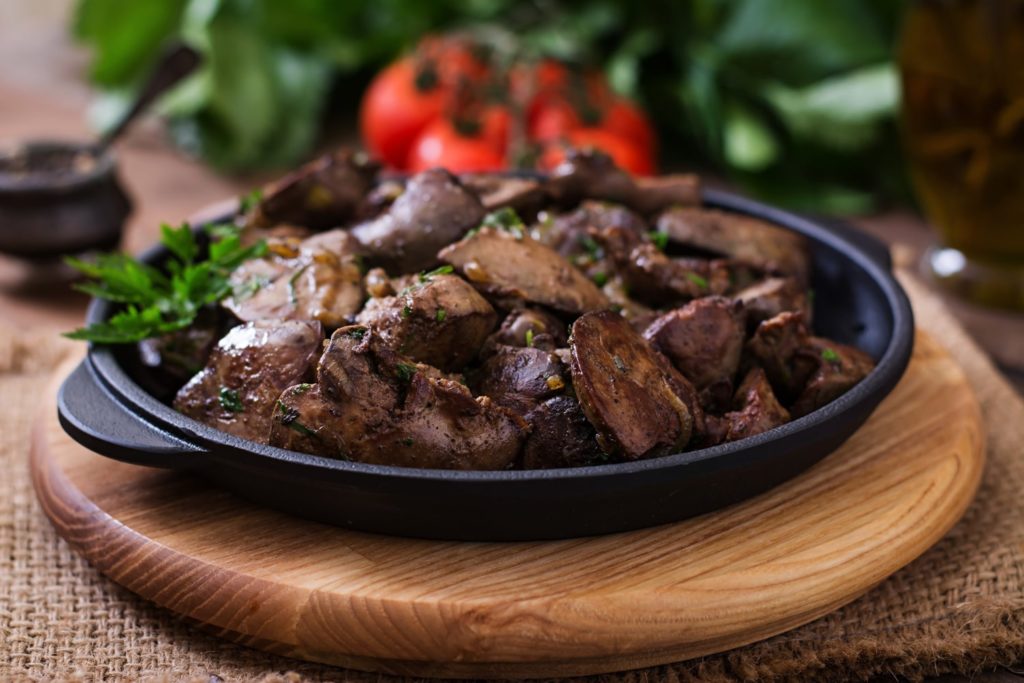
Hannah Zheng
Undergraduate in BSc Nutrition
Jump to:
- What is Vitamin B9?
- Vitamin B9 deficiency
- Different types of Vitamin B9
- Health Benefits
- Health Claims
- Best sources of Vitamin B9
- Daily requirements and intake
- How to take Vitamin B9
- Signs and symptoms of deficiency
- Risk and side effects
- Interactions - herbs and supplements
- Interactions - medications
- Summary
- Related Questions
Vitamin B9 (Folate) is naturally found in foods, and its synthetic counterpart, folic acid, are essential for health, supporting amino acid synthesis and vitamin metabolism.
This article explores folate’s role during pregnancy, sources, daily requirements, deficiency risks, and the impact of folic acid fortification in foods.
What is Vitamin B9?
Vitamin B9, also known as folate, is a water-soluble vitamin that is crucial for a range of bodily functions. It especially has a key role during periods of growth and development, such as pregnancy and foetal development.[1]
Vitamin B9 also plays an important role in
In 2023, it was made mandatory to fortify non-organic wheat flour used for bread making with folic acid.[3]
Folic acid fortification of foods has been made mandatory in more than 80 countries and its inclusion has been seen to be associated with lower rates of neural tube defects.[3]
History behind Vitamin B9
Folate was first discovered in the 1930s by Lucy Wills. It started with her discovering a substance in yeast that helped pregnant women with anaemia.
This substance was later found to be folic acid, a type of vitamin B9.[4]
Vitamin B9 deficiency
Vitamin B9 deficiency is known as folate deficiency anaemia, defined as <3ng/mL. Individuals that have vitamin B9 deficiency are more likely to develop megaloblastic anaemia, where red blood cells are enlarged and dysfunctional.[2,5,6]
Vitamin B9 deficiency is rare but it can definitely occur due to three main reasons which will be discussed more below:
- Decreased intake (Malabsorption or malnutrition)
- Impaired absorption (Chronic alcoholism, genetic disorders)
- Increased requirements (Breastfeeding, pregnancy, health conditions, medical interactions)[7]
Who is most at risk of Vitamin B9 deficiency?
Pregnant women
During pregnancy, the body’s need for folic acid is significantly increased to assist in the rapid growth and development of the foetus, inadequate intake can result in deficiency.[8]
It is important to take a daily supplement of 800 mcg of folic acid one month before and during the first three months of pregnancy.
Consuming adequate amounts of folate as well as supplemental folic acid can help prevent neural tube defects and lower the risk of premature gestational age birth.[9]
Vitamin B9 can help prevent neural tube defects
Certain medical conditions
In healthy individuals, folate is primarily absorbed in the jejunum (upper small intestine) and converted into its active form prior to entering the bloodstream. The liver stores and releases folate when required and the excess is excreted.[5]
However, individuals with certain medical conditions become more susceptible to vitamin B9 deficiency such as:
- Autoimmune diseases, coeliac disease: Intestinal wall/lining is damaged therefore absorption of folate is inhibited.[10]
- Liver diseases, Cirrhosis: Impairs the liver’s ability to produce bile required for folate absorption.[11]
- Kidney disease: Disrupts the body’s ability to metabolise and excrete folate.[12]
- Inflammatory Bowel Disease: Crohn’s disease and ulcerative colitis, where Inflammation to the gastrointestinal tract disrupts folate metabolism, causing malabsorption of folate.[13]
Alcoholism and smoking
Excessive consumption of alcohol reduces the activity of the two proteins that regulate absorption in the intestines, in turn, decreasing liver uptake and accelerates renal excretion of folic acid, leading to a deficiency.[14]
People with alcoholism also tend to eat poor-diets low in folate.
Elderly individuals and medications
As people age, the body’s ability to absorb nutrients declines and diets become less nutrient-dense. This in turn can make elderly individuals more susceptible to folate deficiency.[15]
Medications like methotrexate are known to directly cause folate deficiency especially in elderly individuals. Methotrexate inhibits an enzyme that converts folate into the active form in the body.[5]
Genetic disorders
Methylenetetrahydrofolate (MTHFR) is a critical enzyme for almost all biological processes that involve folate. MTHFR gene mutation means that folate cannot be converted to the active form that’s used in the body.[1]
Hereditary folate malabsorption is a mutation in SLC46A1 gene where absorption of folate in the intestines is impaired causing systemic folate deficiency.[16]
Different types of Vitamin B9
Vitamin B9 comes in two forms:
- Folate: Naturally present in foods but lacks stability during food storage and preparation.
- Folic acid: Synthetic version but it is very stable so it’s used in supplements and for fortifying foods.[17]
Both forms of vitamin B9 require to be converted into the circulating form, 5-Methyltetrahydrofolate, the form that is found in blood and umbilical cord.[18]
Health benefits of Vitamin B9
Vitamin B9 is crucial for supporting DNA synthesis, cell division, red blood cell production, and it is especially crucial during pregnancy. Consuming adequate amounts of vitamin B9 offers various health benefits which are discussed further.
DNA synthesis and cell division
Folate helps to produce nucleotides, the building blocks of DNA, necessary for DNA replication and repair. It also aids in creating purines, another component of DNA.[19,20]
All these processes are vital for cell division, especially during periods of rapid growth, such as pregnancy. Therefore, adequate folate consumption is crucial for DNA synthesis and cell division.
Pregnancy and prevention of neural tube defects
Folate and folic acid are especially important for foetal development
In the early stages of pregnancy when the neural tube is forming it helps to ensure the proper closure of it.[23]
If inadequate amounts of vitamin B9 are consumed, abnormalities in both the mother and foetus can occur.
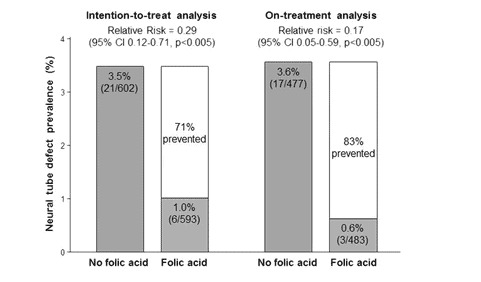
Red blood cell formation
Erythropoiesis is the process in which red blood cells are produced. In this process, folate, vitamin B12 and iron are essential for erythrocyte production as they’re required for proliferation during the differentiation process.[24]
Deficiency can cause decreased erythrocyte production causing anaemia.
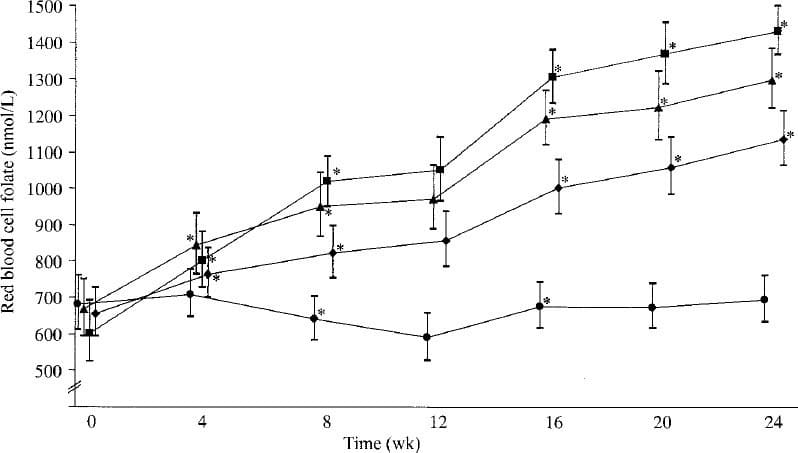
Ensuring that there are adequate levels of vitamin B9 is crucial for the body to produce healthy red blood cells, important for overall health and bodily functions.
Regulation of homocysteine
Vitamin B9, B12, and B6 play a role in regulating homocysteine (an amino acid that interacts with those B vitamins to create other proteins needed in the body).
Without these key B vitamins, elevated circulating levels of total homocysteine have been implicated in the development of cardiovascular diseases.[25,26]
Folate deficiency can cause higher levels of homocysteine in the blood. Taking vitamin B9 alongside vitamin B6 can help treat high levels of homocysteine in the blood. This in turn can help prevent hyperhomocysteinemia.[27]
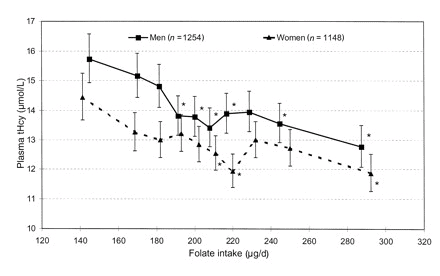
The study observed that upon higher consumption of folate in both women and men, homocysteine levels decreased.
It was also observed that both drinking alcohol and smoking can affect homocysteine levels.[27]
Health claims that still need more evidence and research
The impact of vitamin B9 on various aspects of health is well-documented, there are still some ongoing discussions about potential benefits that require further research before definite conclusions can be drawn.
Dementia and cognitive function
Studies have found associations between high homocysteine levels and increased incidence of dementia and Alzheimer’s disease. Homocysteine can negatively affect the brain by causing a lack of blood to the brain and nerve cells.[28]

Depression
Folate plays a role in various central nervous system functions. It is observed that individuals with depression exhibit low levels of serum and red blood cell folate.[29]
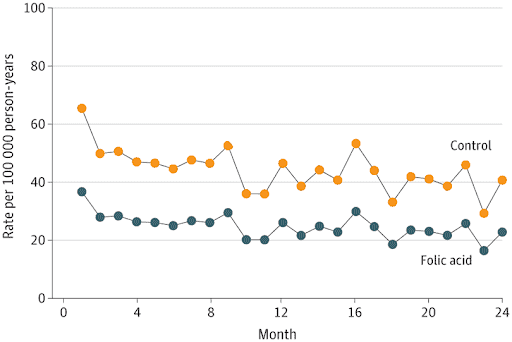
When folic acid supplementation is consumed, research indicates a reduction in the incidence of self-inflicted fatal injuries compared to when there is no supplementation.
This suggests that adequate folate levels may play a protective role in mental health, potentially lowering the risk of self-inflicted fatal injuries.
Although more research is required, ensuring adequate intake of vitamin B9, whether through diet or supplements, could provide support in individuals experiencing depressive symptoms.
RELATED — Depression Signs and Symptoms: Stop the downward spiral in time (Part 1)
Sleeping
Some studies have shown that high levels of serum folic acid are related to less difficulty in falling asleep.[30]
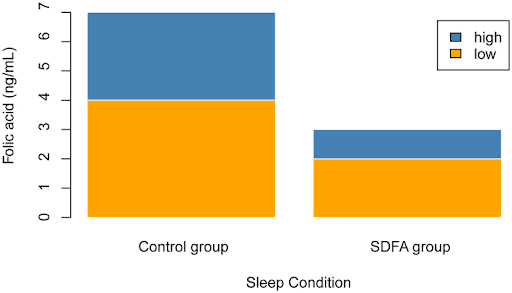
It was observed that participants with severe difficulties in falling asleep had lower serum folic acid levels compared to people who did not have difficulty falling asleep.
RELATED — Great Sleep means Great Health: 17 Health Benefits of Good Sleep
Supplementation with folic acid can be helpful in people who have difficulty in falling asleep.
Best sources of Vitamin B9
Folate is naturally found in most foods, incorporating adequate folate into your diet is essential for overall health and well-being.
Food Source | Concentration (mcg per 100g) |
Chicken Liver | 560 |
Edamame | 311 |
Peanuts | 240 |
Lentils (cooked) | 181 |
Chickpeas (cooked) | 172 |
Asparagus (cooked) | 149 |
Spinach (cooked) | 146 |
Romaine Lettuce | 136 |
Avocado | 81 |
Chinese cabbage | 66 |
Broccoli (cooked) | 63 |
Brussel sprouts | 61 |
Egg (hard boiled) | 44 |
Oranges | 30 |
Banana | 20 |
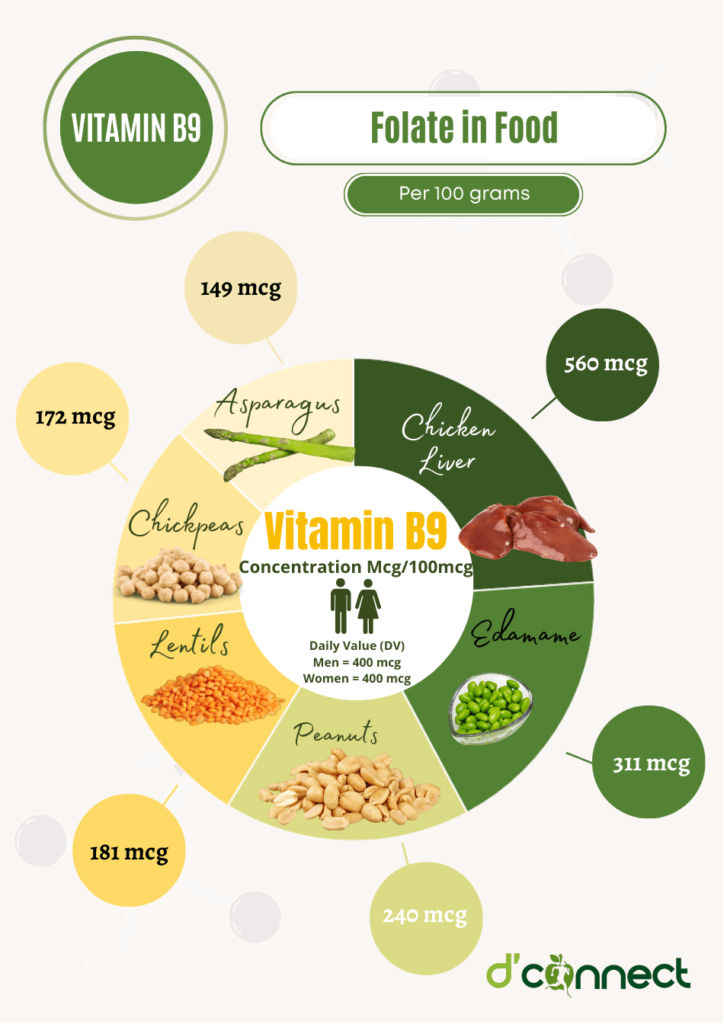
When cooking vegetables, consider steaming rather than boiling. Boiling can cause significant loss of folate as it leaches into the cooking water.[31]
If you are boiling, consider using the cooking water in soups or gravy to optimise folate intake.
Daily requirements and recommended intake
The daily requirements below are from the Nutrient Reference Values (NRV) for Australia and New Zealand as well as the Ministry of Health.[32]
Age group | Male (mcg/day) | Female (mcg/day) |
Infants (0-6 months) | 65 | 65 |
Infants (7-12 months) | 80 | 80 |
Children and Adolescents | – | – |
1-3 years | 150 | 150 |
4-8 years | 200 | 200 |
9-13 years | 300 | 300 |
14-18 years | 400 | 400 |
Adults (>18 years) | 400 | 400 |
Pregnancy | – | – |
14-18 years | 600 | |
19-30 years | 600 | |
31-50 years | 600 | |
Lactation | – | – |
14-18 years | 500 | |
19-30 years | 500 | |
31-50 years | 500 |
The upper limit is estimated to be 1000 mcg/day for folic acid intake.
How to take Vitamin B9 as a supplement
Folic acid is often included in many multivitamin supplements as well as standalone folic acid supplements.
There are different types of folic acid supplements:
- Oral (Powdered, capsules, tablets, liquid)
- Intravenous
- Subcutaneous
- Intramuscular
Folic acid supplementation may be necessary for some individuals, but typically a balanced diet rich in whole foods is the best way to meet nutritional needs.
It is important to consult and seek guidance from a healthcare professional before incorporating folic acid supplements into your routine.
Common signs and symptoms of Vitamin B9 deficiency
Vitamin B9 deficiency can present in varying symptoms, in which these symptoms can include:
- Weakness
- Fatigue
- Shortness of breath and/or difficulty breathing
- Hair loss and pale skin
- Mouth sores
- Headaches
- Difficulty concentrating
- Irritability.[33]
Vitamin B9 risk and side effects
It’s rare to reach a toxic level when only consuming from a diet. Toxicity typically occurs when supplementation is involved.
Consuming excessive folic acid can delay the diagnosis of vitamin B12 deficiency
This can potentially lead to irreversible neurological damage. Also, this is known as masking vitamin B12 deficiency.[34]
Possible interactions with herbs and supplements
Possible interactions with herbs and supplements
There are some herbal supplements like
that can be consumed in conjunction with vitamin B9.[35]
While these are generally beneficial for various health purposes, it’s important to be mindful of their folate content and their possible interactions with folic acid, especially when incorporating them into your routine.
If consumed alongside folate-rich foods and supplements, it can lead to an overconsumption of vitamin B9.
Supplements like:
- Vitamin B12
- Vitamin B6
- Vitamin C
- Zinc
- Fish oil
- Iron
- Probiotics
RELATED — Introduction to Probiotics: Our immunity boosters
These can be consumed in conjunction with vitamin B9 but their exact interaction with folate can vary.[36]
It’s advisable to seek guidance or advice from a healthcare professional or dietician before adding any herbs or supplements into your routine.
Possible interactions with medication
There are a few medications that do not typically contain high levels of folic acid, instead they can directly affect folate levels by inhibiting the absorption or the conversion of folate/folic acid into the active form thereby causing deficiency.[37]
Here are a few listed:
- Autoimmune medication: Methotrexate
- Anticonvulsants: Phenytoin
- Sulfasalazine
- Antibiotics: Trimethoprim
- Antiepileptic drugs[5,26,36]
If taking oral contraceptives and methylprednisolone, it is recommended to take folic acid supplements.[22]
All these medications can affect either folate absorption and/or folate levels.
It would be best to seek professional medical advice first before taking folic acid supplements.
Summary
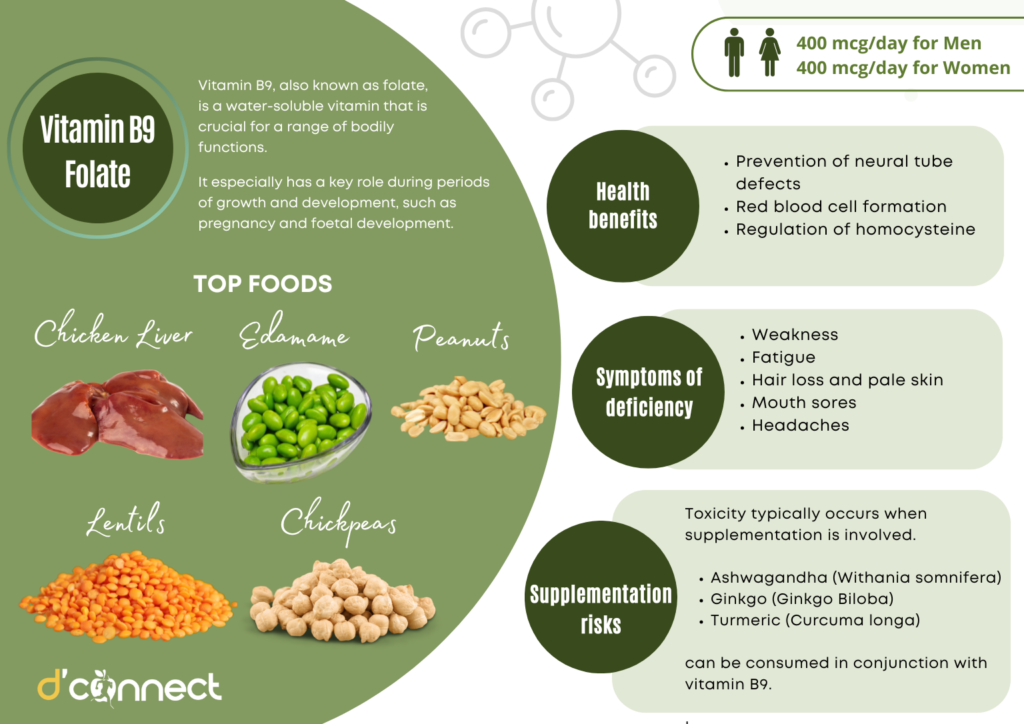
Key Takeaway — In this illustration we have outlined the most important information that you should know about Vitamin B9.
Related Questions
1. What is the difference between folic acid and folate?
Folate is the natural form of vitamin B9 found in foods, while folic acid is the synthetic form used in supplements and fortified foods.
2. How much folate is needed during pregnancy?
During pregnancy, it is recommended to consume 600 micrograms per day, whether it’s from foods or supplements.
3. How does folate affect mental health?
Folate supports mental health by aiding neurotransmitter synthesis and reducing homocysteine levels, both linked to depression. Adequate folate intake can enhance antidepressant effectiveness and improve mood regulation.
If you have any questions about Vitamin B9, please let us know in the comment section below.
Hannah is currently pursuing a Bachelor of Science degree majoring in Nutrition, with aspirations of advancing to Masters in Nutrition and Dietetics in the future. Her academic journey has fueled her interests in childhood nutrition, supplemental nutrition, and the intricacies of nutritional marketing.
References
(1) Greenberg, J. A., Bell, S. J., Guan, Y., et al. (2011). Folic acid supplementation and pregnancy: More than just neural tube defect prevention. Reviews in Obstetrics and Gynecology. Retrieved from https://www.ncbi.nlm.nih.gov/pmc/articles/PMC3218540/
(2) Folate and folic acid. Folate and Folic Acid – Health New Zealand | Te Whatu Ora. Retrieved from https://www.tewhatuora.govt.nz/health-services-and-programmes/nutrition/guidance-on-nutritional-supplements/folate-and-folic-acid/#aotearoa-new-zealands-policy-for-folic-acid-supplementation
(3) Industries, M. for P. (2023). Folate and the addition of folic acid to food: NZ Government. Ministry for Primary Industries. Retrieved from https://www.mpi.govt.nz/food-safety-home/nutrients-added-food/folate-and-the-addition-of-folic-acid-to-food/
(4) Rosenberg I. H. (2012). A history of the isolation and identification of folic acid (folate). Annals of nutrition & metabolism, 61(3), 231–235. https://doi.org/10.1159/000343112
(5) Khan, K. M. (2023). Folic acid deficiency. StatPearls. Retrieved from https://www.ncbi.nlm.nih.gov/books/NBK535377/
(6) Serum and red blood cell folate concentrations for assessing. (2012). Retrieved from https://iris.who.int/bitstream/handle/10665/75584/WHO_NMH_NHD_EPG_12.1_eng.pdf
(7) Green, R. (2011). Indicators for assessing folate and vitamin B12 status and for monitoring the efficacy of intervention strategies. Food and Nutrition Bulletin, 94(2), 666S-672S. https://doi.org/10.1177/15648265080292s108
(8) Fekete, K., Berti, C., Trovato, M., et al. (2012). Effect of folate intake on health outcomes in pregnancy: a systematic review and meta-analysis on birth weight, placental weight and length of gestation. Nutrition Journal, 11(75). https://doi.org/10.1186/1475-2891-11-75
(9) Bo, Y., Zhu, Y., Tao, Y., et al. (2020). Association Between Folate and Health Outcomes: An Umbrella Review of Meta-Analyses. Frontiers in public health, 8. https://doi.org/10.3389/fpubh.2020.550753
(10) Said, H. M. (2013). Recent advances in transport of water-soluble vitamins in organs of the digestive system: A focus on the colon and the pancreas. American Journal of Physiology-Gastrointestinal and Liver Physiology, 305(9), G601–G610. https://doi.org/10.1152/ajpgi.00231.2013
(11) M. P. Look, R. Riezler, C. Reichel, K. A., et al. (2000). Is the Increase in Serum Cystathionine Levels in Patients with Liver Cirrhosis a Consequence of Impaired Homocysteine Transsulfuration at the Level of ?-Cystathionase? Scandinavian Journal of Gastroenterology, 35(8), 866–872. https://doi.org/10.1080/003655200750023255
(12) Cianciolo, G., De Pascalis, A., Di Lullo, L., et al. (2017). Folic acid and homocysteine in chronic kidney disease and cardiovascular disease progression: Which comes first. Cardiorenal Medicine, 7(4), 255–266. https://doi.org/10.1159/000471813
(13) Pan, Y., Liu, Y., Guo, H., et al. (2017). Associations between Folate and Vitamin B12 Levels and Inflammatory Bowel Disease: A Meta-Analysis. Nutrients, 9(4), 382. https://doi.org/10.3390/nu9040382
(14) Yallew, W., Bamlet, W. R., Oberg, A. L., et al. (2017). Association between Alcohol Consumption, Folate Intake, and Risk of Pancreatic Cancer: A Case-Control Study. Nutrients, 9(5), 448.
(15) Reynolds, E. H. (2002). Folic acid, ageing, depression, and dementia. BMJ, 324(7352), 1512–1515. https://doi.org/10.1136/bmj.324.7352.1512
(16) Tan, J., Li, X., Guo, Y., et al. (2017). Hereditary folate malabsorption with a novel mutation on SLC46A1: A case report. Medicine, 96(50), e8712. https://doi.org/10.1097/MD.0000000000008712
(17) Crider, K. S., Bailey, L. B., & Berry, R. J. (2011). Folic acid food fortification-its history, effect, concerns, and future directions. Nutrients, 3(3), 370–384. https://doi.org/10.3390/nu3030370
(18) Carboni L. (2022). Active Folate Versus Folic Acid: The Role of 5-MTHF (Methylfolate) in Human Health. Integrative medicine, 21(3), 36–41. Retrieved from https://www.ncbi.nlm.nih.gov/pmc/articles/PMC9380836/
(19) Duthie, S. J., Narayanan, S., Brand, G. M., et al. (2002). Impact of folate deficiency on DNA stability. The Journal of Nutrition, 132(8), 2444S-2449S. https://doi.org/10.1093/jn/132.8.2444s
(20) Bailey, L. B., & Gregory, J. F. (1999). Folate metabolism and requirements. The Journal of Nutrition, 129(4), 779–782. https://doi.org/10.1093/jn/129.4.779
(21) Wald, N.J., Morris, J.K. & Blakemore, C. (2018). Public health failure in the prevention of neural tube defects: time to abandon the tolerable upper intake level of folate. Public Health Reviews, 39(2). https://doi.org/10.1186/s40985-018-0079-6
(22) Scholl, T. O., & Johnson, W. G. (2000). Folic acid: Influence on the outcome of pregnancy. The American Journal of Clinical Nutrition, 71(5), 1295S-1303S. https://doi.org/10.1093/ajcn/71.5.1295s
(23) Ebara, S. (2017) Nutritional role of folate. Congenital Anomalies, 57, 138–141. https://doi.org/10.1111/cga.12233
(24) Lamers, Y., Prinz-Langenohl, R., Brämswig, S., et al. (2006). Red Blood Cell folate concentrations increase more after supplementation with [6 s]-5-methyltetrahydrofolate than with folic acid in women of childbearing age. The American Journal of Clinical Nutrition, 84(1), 156–161. https://doi.org/10.1093/ajcn/84.1.156
(25) Yuan, S., Mason, A.M., Carter, P. et al. (2021). Homocysteine, B vitamins, and cardiovascular disease: a Mendelian randomization study. BMC Medicine 19(97). https://doi.org/10.1186/s12916-021-01977-8
(26) Kennedy D.O. (2016). B Vitamins and the Brain: Mechanisms, Dose and Efficacy–A Review. Nutrients, 8(2), 68. https://doi.org/10.3390/nu8020068
(27) Bakker, R. C., & Brandjes, D. P. M. (1997). Pharmacy World and Science, 19(3), 126–132. https://doi.org/10.1023/a:1008634632501
(28) Zhang, X., Bao, G., Liu, D., et al. (2021). The Association Between Folate and Alzheimer’s Disease: A Systematic Review and Meta-Analysis. Frontiers in neuroscience, 15. https://doi.org/10.3389/fnins.2021.661198
(29) Liwinski, T., & Lang, U. E. (2023). Folate and its significance in depressive disorders and suicidality: A comprehensive narrative review. Nutrients, 15(17), 3859. https://doi.org/10.3390/nu15173859
(30) An, H., Xue, Q., & Zhang, J. (2023). The association between serum total folic acid concentration and severe difficulty falling asleep in US adults: NHANES 2005-2008. Frontiers in neurology. https://doi.org/10.3389/fneur.2023.1225403
(31) McKillop DJ, Pentieva K, Daly D, et al. (2007). The effect of different cooking methods on folate retention in various foods that are amongst the major contributors to folate intake in the UK diet. British Journal of Nutrition. 88(6), 681-688. https://doi.org/10.1079/BJN2002733
(32) Nutrient reference values for Australia and New Zealand including recommended dietary intakes. (2006).
(33) Hanna, M., Jaqua, E., Nguyen, V., & Clay, J. (2022). B Vitamins: Functions and Uses in Medicine. The Permanente journal, 26(2), 89–97. https://doi.org/10.7812/TPP/21.204
(34) Patel, K., Sobczyńska-Malefora, A. (2017). The adverse effects of an excessive folic acid intake. European Journal of Clinical Nutrition, 71, 159–163. https://doi.org/10.1038/ejcn.2016.194
(35) Bright-Gbebry, M., Makambi, K. H., Rohan, J. P., et al. (2011). Use of multivitamins, folic acid and herbal supplements among breast cancer survivors: the black women’s health study. BMC complementary and alternative medicine, 11(30). https://doi.org/10.1186/1472-6882-11-30
(36) Koury, M. J., & Ponka, P. (2004). New insights into erythropoiesis: The roles of folate, Vitamin B12, and iron*1. Annual Review of Nutrition, 30, 105-131. Retrieved from https://www.annualreviews.org/content/journals/10.1146/annurev.nutr.24.012003.132306
(37) Schechter, L., Worthington, P. (2004). Drug-Nutrient Interactions Involving Folate. Handbook of Drug-Nutrient Interactions, 271-284. https://doi.org/10.1007/978-1-59259-781-9_15

